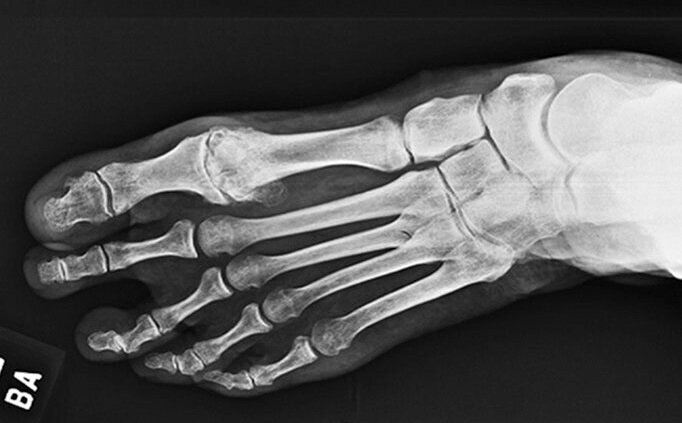Hallux Limitus
The Highlights
Hallux Limitus is restricted motion in the big toe joint caused by arthritic changes making the joint thicker with bony prominences over it's top margins, often involving pain.
In our clinic, we can diagnose this problem easily with physical examination and occasionally with the added use of diagnostic ultrasound.
Treatment involves protecting the joint from painful end-range motion using appropriate footwear, taping and foot orthoses (specialist insoles). Other treatments to improve the condition can include joint mobilisation techniques and steroid injections.
What is it and what are the symptoms?
Osteoarthritis (OA) of the 1st metatarsal-phalangeal joint (MTP joint), i.e. the big toe joint, is an exceptionally common problem we see in clinic. It's thought to be about as common as hip arthritis and despite not being talked about nearly as much, it can be highly painful and debilitating. Hallux limitus is the term used to described reduce range of motion in the joint, usually secondary to arthritis.
There is often a thickening (what we call osteophytes) at the dorsal (top) margins of the joint which may be seen and felt when pressing across it - this pressing along with both upward and downward bending of the joint can provoke symptoms. As can any weightbearing activity where the toe bends. Like a lot of arthritic pains, it will often be worse in the morning, ease with a little movement and get worse as the day goes on.
Stiffness in the MTP joint is also a common feature with reduced upward bending motion available. This is partly to do with thickening of the joint capsule but more to do with a "bony block" where the thickened margins on the top of the joint line hit against one another.
Why does it happen?
A number of factors can lead to MTP joint OA; Trauma to the joint either recently or in the past can increase the risk of developing OA and is often reported when we see it in younger individuals. Other joint conditions like rheumatoid arthritis and gout may damage the joint and lead to secondary OA. Another important consideration is your gait and biomechanics (which our team can look into). There are also genetic factors that seem to put some people at increased risk and family history may give this away. A lot of the time though we simply see this as normal age-related joint changes and that's important to understand because not all joint changes should be a cause for concern. However, pain is not normal and we should certainly be able to help if your joint hurts or is otherwise affecting your ability to enjoy normal daily tasks.
What are the treatment options?
This will depend a lot on what stage the joint OA is at. This is decided based on your symptoms, clinical presentation and, as we often employ in our practice, diagnostic ultrasound imaging to visualise the joint and surrounding soft tissues in more detail.
The bending motion of the toe is what applies stress to the joint and can impact on the changes we see. If the problem is in an early stage, the goal is to improve mobility in the joint and encourage regeneration. This can be achieved through mobilisation techniques which we teach patients how to perform at home and foot orthoses (specialist insoles) to change the mechanics of how the joint behaves. It may also involve techniques to help protect the joint like taping and advice on appropriate footwear (stiff soled or rocker shoes are super helpful whilst very flexible shoes usefully make things worse).
If the condition is a bit more advanced (which is probably 90%+ of the time when people see us) the goal is still to preserve joint health but to focus more heavily on protecting the joint from what will now likely be quite painful bending motions. The shoe advice becomes more important than ever and can be augmented further with a specialist carbon plate insert that essentially stops almost all bending motion at the MTP joint when walking in shoes. We are also a big fan of corticosteroid injections which, in our practice, we perform following a small local anaesthetic first to ensure it is as close to painless as we can achieve.
We find very few patients will fail conservative treatment if done properly but if it happens, we also have some excellent ties with both NHS and Private Practice orthopaedic surgeons who can offer a number of options from cheilectomies (shaving off the overgrown bone to improve motion), joint fusions and even joint replacements. All of which we can help explain before you go down that route of enquiry.




